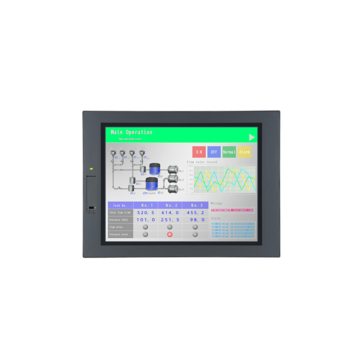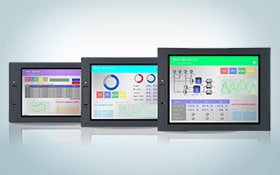HMI

Touch panels that meet the diverse needs of production sites. Take advantage of features that keep your machines and processes running efficiently.
Product Lineup

Features

Windows OS Embedded HMI with Machine Operation Recorder Playback Function(VT5-WX)
When the KV-8000A PLC records data related to a production error, the VT5-WX can display the recorded data directly on the touch panel.

Supports Large Equipment with Complex Functionality (VT5-X/W)
The VT5 Series touch panel displays offer not only a high-resolution XGA display with 16 million colors but also a variety of standard interfaces including RGB input and connectability to vision systems.
A human-machine interface (HMI) in modern industry is typically an operating interface that uses a touch panel equipped with a CPU and program memory and that allows for signal and numerical data communications with a PLC.
You can program push button switches, indicators, and counters on the HMI, and its data communication capability with PLC programs makes it easy to operate indicator lights, solenoids, and other external output devices from the HMI as needed.
Programs are written into the HMI memory from a computer that has dedicated drawing programming software installed.
Benefits of HMI
Conventionally, a large number of switches for operator use, as well as indicators, counters, and timers that indicate work statuses were mounted on the control panel.
For this reason, mounting switches and indicators costs time and money for drilling holes into the control panel and wiring.
An HMI saves wiring time and space because of dedicated programs that allow for flexible drawing and consolidation of switches and other parts on the HMI.
Adding physical switches and indicators for system remodeling incurs costs and days of work to remake and drill the operating panel and add new wires. If there is not enough space, holes need to be drilled into the side of the operating panel, which is just one example of having to work within limits.
With an HMI, switches can be added and layouts changed with the software as needed, which allows for flexible implementation of modifications.
An HMI can be connected with a PLC and other companies’ products, such as inverters and robots without any programming.
You can easily set up data communication for settings and current values with multiple devices.
HMI Case Studies
Space-saving and improved workability with a single monitor for vision systems
In addition to an operating touch panel, each vision system conventionally needed a monitor, and its console and mouse were directly connected to the vision system controller with cables routed and replaced accordingly. However, with an HMI, there only needs to be one display for all vision systems, which can also be operated using a shared console and mouse connected to the HMI by switching between vision systems.
Shorter recovery time and improved workability with PDF display
When a problem occurs, retrieving instruction manuals from the office can take time, and operations may be inefficient when you have to work while holding the manual.
In contrast, an HMI can display PDF files for quick browsing at the worksite, which can speed up troubleshooting.
HMIs are VESA-mountable. Installing one in an easy-to-see location to display information frees up both of your hands, which helps make work more efficient.
Shorter inspection and recovery time with audible alerts
Alarms that are only visually displayed can go unnoticed, so reactions to problems may be delayed.
Using an HMI audio output function, you can create mechanisms for early detection of problems on site by playing voice messages in sync with the alarm display. Additionally, you can create troubleshooting procedures to display along with voice messages.
Frequently Asked Questions About HMI
In general, HMIs are available in sizes from 4 inches to 15 inches. HMIs are available in two types: panel-mounted and handheld types.
Data transmission is available through serial communication connections such as RS-232C and Ethernet.
HMIs and PLCs of different brands can be connected. Please check the connectible PLCs for each HMI.
